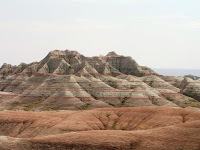SD Saga: There and Back Again
The final days of our trip were spent packing, prepping, and driving.
Even though our touring around had ceased, I still managed to see one last life bird on our final day in South Dakota: a Gray Jay! It landed outside our cabin to snatch a piece of stale bread we had thrown out. I couldn't believe my luck! It hung around just long enough for me to get a good visual and identify it quickly, before it disappeared into the ponderosa forest once more.
The next day at the crack of dawn, we loaded up the car and bade farewell to our cozy cabin for the last time.
I had mixed feelings about leaving South Dakota. In one respect, I was happy to be heading home; the traveling life had taken a toll on all of us I think. But in another respect, I knew I was going to miss the Black Hills. I really loved the mountains, crystal clear creeks, hilly meadows, vibrant wildflowers, and clean, pure air. There was something about the Hills that seemed so rudimentary and wholesome.

At one point, we passed the town of Lost Springs, WY, whose highway sign reads: "Lost Springs. Elevation: 4995 ft, Population: 1." (A quick internet search later revealed that there are actually 3 people in the town as of this year. Go figure!)
About 7 hours after leaving SD, we made it back to the Colorado Rockies. Although it was mid-August, little patches of snow could be seen from afar on the tops of some of the peaks.


That was about the point where I lost my camera. We had gone to dinner at a restaurant near the hotel, and I shoved my camera under the seat in the car, as I usually do to keep it out of sight when I'm not taking it with me.
Well, it had been a very long day as you can imagine, and when we got back to the hotel I completely forgot to pull it out again. When we were packing up at 4am the next morning, I assumed it was already in my backpack, and even thought I felt the strap when I reached in.
Around 7pm that night when I got home and settled in, I went to upload my pictures and you can guess the horror when I realized it was gone. My beloved Olympus SP-560uz 18x Optical Zoom, 8.0 Megapixal digital camera that I got for my 18th birthday was no more.
After a week of calling the rental car company (during which time our car was rented out twice) they finally searched it and did not find the camera. So, someone somewhere has it. All I can say is, I hope they're enjoying it.
Well, I may be camera-less, but the memories from the trip live on. As I finished the last entry in my travelogue, I closed it with an open mind.
Life is amazing. Hard sometimes, but amazing. I love this world, and to have the opportunity to explore even a small corner of it is a true gift.
Until next time,
Happy travels and happy birding!
Labels: colorado, South Dakota, travel, wyoming

 Near the top, we came across an enormous mine shaft-type building towering up out of the terrain like an abandoned fortress. Before checking it out though, we hiked the rest of the way up to find the geocache.
Near the top, we came across an enormous mine shaft-type building towering up out of the terrain like an abandoned fortress. Before checking it out though, we hiked the rest of the way up to find the geocache.




































